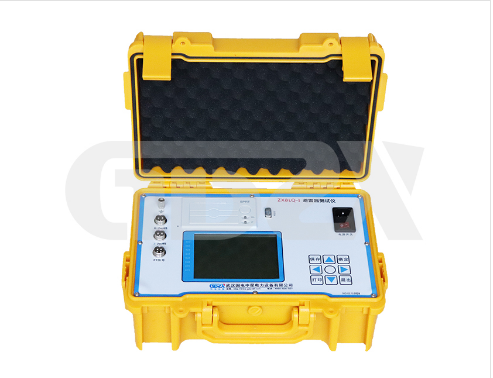NEWSnews
Advanced Field Testing of Zinc Oxide Arresters: The ZXBLQ-I Analyzer
Introduction
Zinc Oxide (MOA) surge arresters are critical protective devices within electrical power systems. Ensuring their integrity through precise electrical performance testing is paramount for system reliability. The ZXBLQ-I Zinc Oxide Arrester Tester represents a significant advancement in portable diagnostic instrumentation, offering comprehensive analysis capabilities suitable for both live-line and offline testing scenarios. This article details its technical capabilities and positions it within the landscape of MOA test equipment.
Core Functionality and Measurement ScopeThe ZXBLQ-I excels in measuring key MOA health indicators beyond basic leakage current:
Current Analysis: Measures total leakage current (I<sub>total</sub>), fundamental resistive current (I<sub>r</sub>), and the harmonic components (3rd, 5th, 7th) of the leakage current. It captures both the fundamental effective value and peak values (including positive and negative resistive peaks - Ir<sup>+</sup>, Ir<sup>-</sup>).
Voltage Analysis: Measures the power frequency reference voltage (U<sub>ref</sub>) and its harmonics.
Phase & Power: Calculates the phase angle difference (Φ) between the fundamental voltage and total current, and determines the active power (Watts) dissipated by the arrester – a direct indicator of losses and potential aging.
Waveform Visualization: Displays real-time voltage and current waveforms on its large LCD screen, enabling visual inspection for abnormalities.
Key Features & Technical Advantages
Versatile Application: Uniquely suitable for live-line testing (enhancing operational efficiency and safety), offline testing (post-maintenance or fault investigation), or laboratory use. Voltage reference can be acquired up to 20m away (extendable).
Enhanced Diagnostics: The ability to isolate and measure the resistive current component (I<sub>r</sub>) and its harmonics is crucial. An increasing I<sub>r</sub>, particularly higher harmonics, is a primary indicator of valve aging, moisture ingress, or internal degradation – defects often masked in total current readings alone. Compared to basic testers measuring only I<sub>total</sub>, the ZXBLQ-I provides significantly deeper diagnostic insight.
Three-Phase Efficiency: Features fully isolated current and voltage sensors. A, B, and C phase arresters can be tested and stored as a single logical group, streamlining substation surveys.
Robust Data Handling: Includes a high-speed thermal printer for immediate hardcopy reports of data and captured curves. Its internal non-volatile memory securely stores up to 200 complete test datasets, allowing extensive field campaigns without external devices. RS232 interface enables data export for further analysis or reporting.
User-Centric Design: Features a large 5.7" (320x240) graphical LCD for intuitive menu navigation, parameter display, and waveform visualization. Housed in a rugged, dustproof, waterproof, and corrosion-resistant engineering plastic case.
Performance: Utilizes high-speed sampling and advanced Digital Signal Processing (DSP) techniques, ensuring strong anti-interference performance and measurement accuracy (±5% for current >100µA, ±2% for voltage >30V) under demanding field conditions.
Portability: Compact dimensions (360x260x140mm) and lightweight (5kg) design make it highly suitable for field deployment.
Technical Specifications Summary
Parameter | Specification |
Power Supply | AC 220V ±10%, 50Hz |
Leakage Current | 0 - 10 mA |
Voltage (Uref) | 30 - 100V (RMS) |
Current Accuracy | >100µA: ±5% rdg ±1 digit |
Voltage Accuracy | >30V: ±2% rdg ±1 digit |
Key Parameters | I<sub>total</sub>, I<sub>r</sub> (F + H3,H5,H7), Ir<sup>+</sup>/Ir<sup>-</sup>, U<sub>ref</sub> & H, Φ, Power |
Data Storage | 200 Groups |
Display | 5.7" Graphical LCD (320x240) |
Printer | High-Speed Thermal |
Interface | RS232 |
Uref Distance | 20m (Standard, Extendable) |
Enclosure | IP Rated Dust/Water/Corrosion Resistant Plastic |
Dimensions (mm) | 360 x 260 x 140 |
Weight | 5 kg |
Comparison and Positioning
While simpler testers exist, they often focus solely on total leakage current or lack the harmonic analysis capability. The ZXBLQ-I distinguishes itself through:
Comprehensive Parameter Set: Measurement of resistive current and harmonics is essential for proactive defect identification, going beyond simple pass/fail checks.
Live-Line Capability: Enables testing without costly outages, a significant operational advantage over many offline-only units.
Field Ruggedness & Portability: Its robust enclosure and weight make it significantly more suitable for harsh substation environments than bulkier lab equipment offering similar analysis.
Data Management: Onboard storage and printing streamline workflow compared to testers requiring immediate PC connection.
Conclusion
The ZXBLQ-I Zinc Oxide Arrester Tester provides power system technicians and engineers with a powerful, portable, and reliable tool for critical diagnostic testing of MOAs. Its ability to perform detailed analysis of resistive current components and harmonics under live-line or offline conditions, coupled with robust data handling and user-friendly design, makes it an excellent choice for effective preventive maintenance programs. By detecting subtle changes indicative of internal moisture or valve degradation early, the ZXBLQ-I plays a vital role in preventing arrester failures and enhancing overall power system reliability.
GDZX is a manufacturer of power detection equipment, offering a diverse range of products with comprehensive models and providing professional technical support. Contact us at +86-27-6552607 or +86-17396104357.Website: http://en.gdzxdl.com/






















